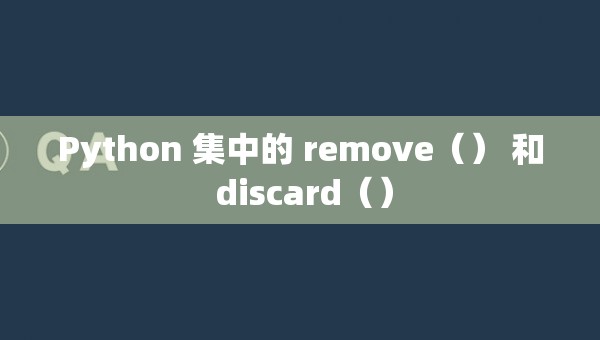- 1最新ChatGPT4.0工具使用教程:GPTs,Midjourney绘画,AI换脸,GPT语音对话,文档分析一站式系统
- 2数据结构--二叉树_#include 二叉树
- 3Tensorflow2.0 tf.data.Dataset.from_tensor_slices 自定义图像数据集 (一)_imgs_batch, labels_batch = next(iter(number_datalo
- 4MATALB曲线拟合与·线性回归_matlab线性回归拟合
- 5实操教学|用Serverless 分分钟部署一个 Spring Boot 应用,真香!
- 6【雕爷学编程】MicroPython动手做(33)——物联网之天气预报_心知天气micropython教程
- 7SpringBoot集成Token
- 8GPT系列总结_gpt1是全量微调吗
- 9position embedding都有什么计算方式
- 10前端Serverless:面向全栈的无服务架构实战 -- 1.Serverless综述(笔记)_前端 serverless
Python 集中的 remove() 和 discard()_python discard和remove
赞
踩

根据一项调查,世界上最常用的编程语言是python。这表明有必要了解 python 中使用的不同编程方法。Pythons以不同的方法存储所有编程数据。一些不同的数据类型是集合、列表、字典。在本文中,我们将了解 python 集以及如何在 python 集中使用 remove() 和 discard() 函数。
删除()
此函数特别用于删除标签的一个特定元素()。它从集合中删除指定的元素,然后显示操作的输出。此方法的唯一限制是它一次只能从指定的数据集中删除一个元素。我们可以通过示例来理解 remove() 函数的使用。我们先来看看 remove() 函数的基本语法是什么:
set.remove(data) #This is the basic form in which the remove() method is used to remove elements
让我们采用两种不同的情况来了解 remove() 函数如何在两种不同的情况下提供输出。
示例 1:存在要删除的元素
Countries = {"India", "London", "Nigeria", "Australia", "Dubai", "Italy", "Kazakhstan", "Iran", "Turkey", "Switzerland"} # The data set contains all the different names Countries.remove("Australia") #Specify using the remove() method the name to be removed from the data set print(Countries)
输出
上述代码的输出将如下所示:
{'Nigeria', 'Switzerland', 'Turkey', 'London', 'India', 'Dubai', 'Italy', 'Kazakhstan', 'Iran'}
示例 2:缺少要删除的元素
Countries = {"India", "London", "Nigeria", "Australia", "Dubai", "Italy", "Kazakistan", "Iran", "Turkey", "Switzerland"} # The data set contains all the different names other then Pakistan Countries.remove("Pakistan") #The remove() method displays an error when the element not present in datset is to be removed print(Countries)
输出
上述代码的输出将是:
KeyError: 'Pakistan' #There will be no output displayed and instead of it such an error will be displayed
丢弃()
此方法使用不同的输出显示方法。在此方法中,输出永远不会显示为错误,如果要删除的元素不在数据集中,则数据将按原样显示,而无需进行任何更改,这与 remove() 方法不同,当元素不存在时,输出将显示为错误。此方法的限制与前一种方法相同,一次只能删除一个元素。我们可以使用以下代码和示例更清楚地理解它:
set.discard(data) #This syntax will always be common in which the element to be removed will be defined in the parentheses
示例 1:存在要删除的元素
Cities = {"Hyderabad", "Bangalore", "Mumbai", "Pune", "Ahmedabad", "Kolkata", "Nagpur", "Nashik", "Jaipur", "Udaipur", "Jaisalmer"} #Different Elements are present in the data set Cities.discard("Kolkata") #If the element will be present in the data set it will be normally removed and the manipulated output will be displayed print(Cities)
输出
上面示例的输出如下所示:
{'Jaisalmer', 'Hyderabad', 'Nagpur', 'Ahmedabad', 'Bangalore', 'Pune', 'Mumbai', 'Udaipur', 'Jaipur', 'Nashik'}
示例 2:缺少要删除的元素
States = {"Hyderabad", "Bangalore", "Mumbai", "Pune", "Ahmedabad", "Kolkata", "Nagpur", "Nashik", "Jaipur", "Udaipur", "Jaisalmer"} #The element name to be discarded is not present in the data set States.discard("Kumbhalgarh") #If the element will not be present in the data set then the output will display the same data set without any manipulation print(States)
输出
上面示例的输出如下所示:
{'Nagpur', 'Jaipur', 'Nashik', 'Hyderabad', 'Ahmedabad', 'Udaipur', 'Pune', 'Jaisalmer', 'Kolkata', 'Bangalore', 'Mumbai'}
两种方法的区别
从数据集中删除所选元素是两种方法的最终目标,但它们的方法和基本原理不同。使用 replace() 函数时,如果必须删除的元素不在提供的数据中,则不会显示结果;相反,将显示错误。但是,当使用 discard() 方法时,事情的工作方式有所不同。如果在使用 discard() 函数时要删除的元素不存在于数据中,则输出将完全按原样显示数据,无需任何修改,并且不会在其位置显示任何错误。
因此,这两种方法都有其专用用途和呈现输出的不同方法,并且它们将根据需要在程序中使用。就像您不确定数据中是否存在任何特定元素并且不希望在运行代码时发生任何错误一样,请使用 discard() 方法,这样即使在元素不存在的情况下,也可以显示输出没有任何错误。
结论
Python是一种有用的编程语言,在全球范围内被程序员用于不同的目的。要成为一名高效和成功的程序员,有必要了解在更短的时间内执行不同任务的不同方法。这是成为一名成功的 python 开发人员并高效快速地工作的唯一关键。
本文展示了 remove() 和 discard() 方法的不同用法以及它们的示例,以使用户更清楚,任何读者都可以参考上述文章来了解有关 remove() 和 discard() 方法的更多信息。


